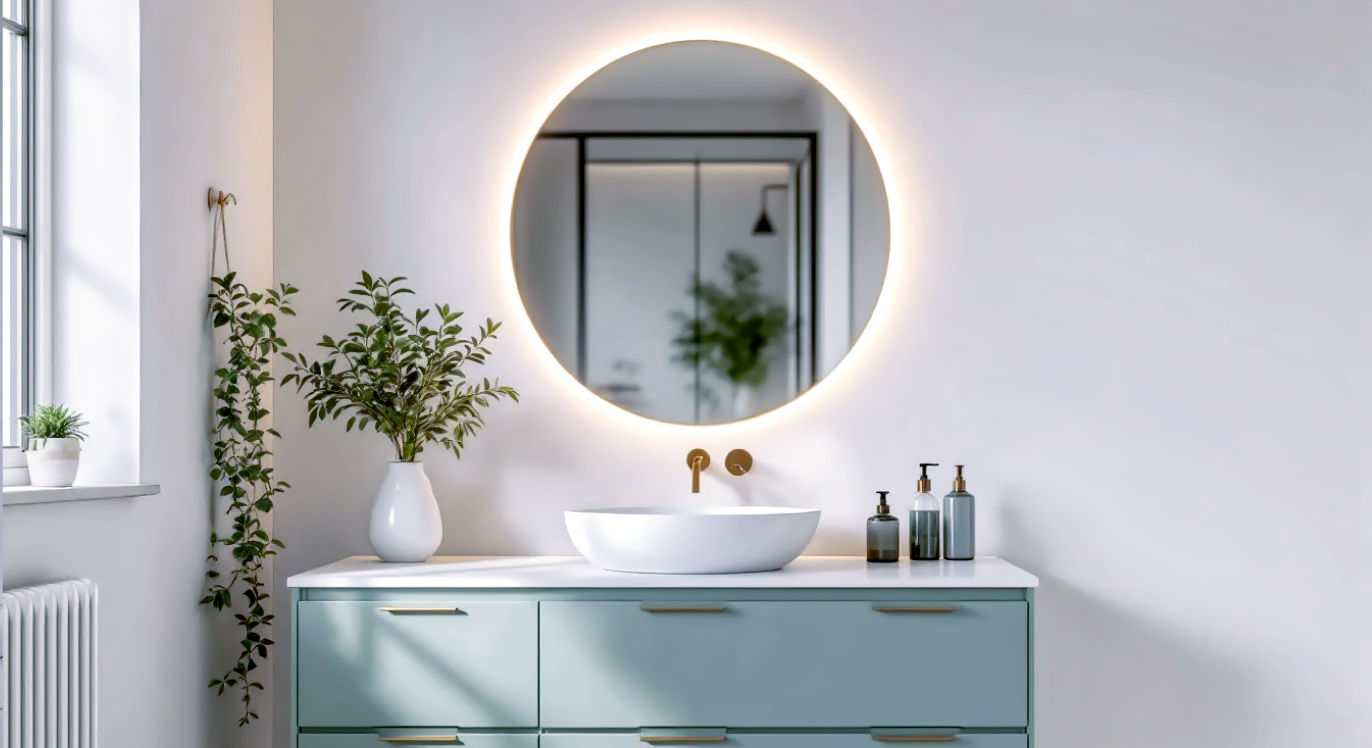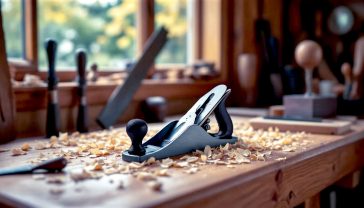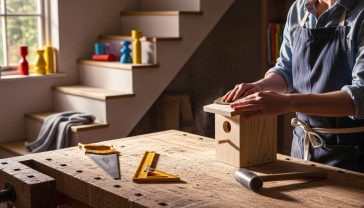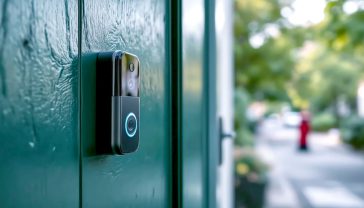Reflecting on Perfection: The British Guide to Choosing Your Bathroom Mirror
From smart mirrors with Bluetooth to simple, elegant frames, choosing a bathroom mirror can be tricky. This complete guide covers it all for the modern British home.

This post may contain affiliate links. If you make a purchase through these links, we may earn a commission at no additional cost to you.
Let’s be honest. The bathroom mirror sees us at our most vulnerable. It’s the first thing we greet on a dark, drizzly Monday morning and the last thing we check before heading out on a Friday night. It’s a silent witness to our daily routines, from the battle with a new razor to the triumphant application of perfect eyeliner. Yet, when it comes to designing a bathroom, we often treat it as an afterthought. A simple piece of glass to hang over the sink, right?
Wrong. So very wrong.
Choosing the right bathroom mirror is one of the most transformative decisions you can make for your space. It’s not just a functional tool; it’s a design powerhouse. The right mirror can make a tiny cloakroom feel palatial, turn a gloomy bathroom into a bright sanctuary, and streamline your morning routine with clever technology you never knew you needed. It’s part interior designer, part taskmaster, part tech wizard.
But with a dizzying array of options out there—from illuminated, all-singing, all-dancing smart mirrors to simple, elegant framed designs—how do you choose the one that’s perfect for you? It can feel overwhelming.
That’s where this guide comes in. We’re going to demystify the entire process, breaking down everything you need to know. We’ll cover size and shape, explore the magic of modern features like demisters and LED lighting, and, most importantly, we’ll tackle the crucial safety regulations you absolutely must understand before you buy. Think of this as your complete, no-nonsense manual to finding the perfect reflection for your home. So grab a cuppa, and let’s dive in.
Chapter 1: The Foundations – Size, Shape, and Style
Before we get dazzled by fancy features, we need to get the basics right. Getting the scale and style of your mirror correct is the foundation of a beautiful and functional bathroom.
Getting the Measure of It: Size and Proportion
The most common mistake people make is choosing a mirror that’s the wrong size for their basin or vanity unit. A mirror that’s too large can overpower the room, while one that’s too small looks lost and a bit pathetic.
The Golden Rule: Your mirror should generally be slightly narrower than your basin or the vanity unit it sits above. This creates a pleasing, balanced look. Aim for a mirror that is about 70-80% of the width of your vanity. For example, if you have an 80cm wide vanity unit, a mirror between 60cm and 70cm wide will look spot on.
Of course, rules are sometimes made to be broken. A full-width, wall-to-wall mirror can look spectacular in a modern bathroom, creating a seamless, hotel-like feel and dramatically increasing the sense of space.
What about height? The key is to ensure the mirror is practical for everyone who will use it. It should be centred at the average eye level of the users. A good rule of thumb is to hang the mirror so its centre is around 1.5 metres (or 5 feet) from the floor. Ensure the top of the mirror is high enough for the tallest person in the house to see themselves properly, and the bottom is low enough for the shortest.
A Shape for Every Space
The shape of your mirror has a huge impact on the overall feel of your bathroom. It’s a chance to either complement your existing design or create an exciting focal point.
- Rectangular & Square Mirrors: These are the timeless classics. They work with almost any décor, from ultra-modern to traditional Victorian. Their clean, straight lines create a sense of order and structure. A landscape (wide) orientation can make a room feel wider, while a portrait (tall) orientation can add a sense of height, which is great for rooms with lower ceilings.
- Round & Oval Mirrors: If your bathroom is full of hard angles and square tiles, a round mirror is a fantastic way to soften the look. The gentle curves introduce a more organic, calming feel. They are particularly popular in Scandi-inspired and contemporary bathrooms. An oval mirror offers a similar softening effect but with a touch of vintage elegance.
- Arched Mirrors: An arched mirror, sometimes called a “cathedral” mirror, adds a touch of architectural grace and sophistication. It draws the eye upward and can feel both classic and modern at the same time, making it a surprisingly versatile choice.
- Pebble & Irregular Shapes: For those who want to make a real design statement, an asymmetrically shaped mirror is the way to go. These organic, pebble-like shapes feel very contemporary and act as a piece of wall art in their own right. They are perfect for breaking up the monotony of a tiled wall.
To Frame or Not to Frame?
This is a key aesthetic decision that defines your mirror’s character.
- Frameless Mirrors: A frameless mirror offers a clean, minimalist look that is perfect for modern bathrooms. With polished or bevelled edges, it blends seamlessly into the wall, which helps to make the space feel bigger and less cluttered. They are also incredibly easy to clean, as there are no nooks or crannies for dust and grime to hide in.
- Framed Mirrors: A frame turns your mirror from a simple utility into a deliberate piece of décor. It’s an opportunity to introduce a new material, colour, or texture into your bathroom.
- Black Frames: A thin black metal frame is a hugely popular choice, perfectly complementing industrial or monochrome design schemes and matching beautifully with black taps and shower screens.
- Metallic Frames: Brass, gold, or brushed nickel frames add a touch of warmth and luxury. They can be coordinated with your taps and hardware for a cohesive, high-end look.
- Wooden Frames: A wooden frame can bring natural warmth and texture to a bathroom, which can sometimes feel a bit cold and clinical. It’s a perfect fit for Scandi, rustic, or spa-inspired designs.
Chapter 2: The Illuminated Mirror – Let There Be Light
If there’s one feature that has truly revolutionised the bathroom mirror, it’s integrated lighting. An illuminated mirror is a total game-changer, providing the perfect light for daily tasks while also adding a beautiful ambient glow to your room.
Why an Illuminated Mirror is Worth Every Penny
The main overhead light in a bathroom is often behind you when you’re standing at the sink. This casts annoying shadows across your face, making tasks like shaving, applying makeup, or putting in contact lenses much harder than they need to be.
An illuminated mirror provides task lighting directly where you need it—on your face. It gives you a clear, even, and shadow-free reflection. This is the kind of flattering, functional light that professional makeup artists use, and it makes a world of difference to your daily routine.
Decoding the Lingo: Lumens, Kelvins, and CRI
When you start shopping for illuminated mirrors, you’ll see a few technical terms. Don’t be intimidated; they’re actually quite simple.
- Lumens (lm): This is simply a measure of brightness. The higher the lumens, the brighter the light. For a bathroom mirror, you don’t need blinding light, just effective light. Anything from 1,000 to 3,000 lumens is usually plenty for task lighting.
- Kelvins (K): This measures the colour temperature of the light. Think of it as the colour of sunlight at different times of the day.
- Warm White (2700K – 3000K): This is a soft, yellowish, cosy light, similar to a traditional lightbulb. It’s great for creating a relaxing, spa-like atmosphere in the evening.
- Cool White / Daylight (4000K – 6000K): This is a crisp, bright, blue-tinged white light that mimics natural daylight. It’s much better for tasks that require colour accuracy, like applying makeup.
- Many modern mirrors are now colour-changeable, allowing you to switch between warm and cool white depending on your mood or task. This is an incredibly useful feature.
- Colour Rendering Index (CRI): This is a scale from 0 to 100 that measures how accurately a light source reveals the true colours of an object. For a bathroom, you want a high CRI (90+). This ensures your foundation actually matches your skin tone and you don’t walk out of the house looking like you got dressed in the dark.
Types of Illumination
LED technology has opened up a world of possibilities for how mirrors are lit.
- Front-lit Mirrors: These have lights, often in frosted strips, on the surface of the mirror itself. This design casts light directly forward onto your face, making it the best option for task lighting.
- Backlit Mirrors (Halo Effect): These have LEDs around the back edge of the mirror. The light washes out from behind the mirror and bounces off the wall, creating a beautiful, soft “halo” effect. This is fantastic for ambient lighting and making the mirror appear as if it’s floating, but it’s not as effective for close-up tasks.
- Edge-lit Mirrors: A hybrid of the two, these mirrors have lights that shine out from the sides of the frame, providing both ambient and functional light.
Chapter 3: Clever Features – The Modern Mirror’s Bag of Tricks
Today’s mirrors do a lot more than just show your reflection. They are packed with technology designed to make life a little bit easier and a lot more luxurious.
The End of Fog: The Magic of Demister Pads
There’s nothing more frustrating than stepping out of a lovely hot shower to find your mirror is completely steamed up. A demister pad (or heated pad) is the beautifully simple solution.
It’s a thin heating element that sticks to the back of the mirror. With the flick of a switch (or often, it comes on automatically with the lights), it gently warms the glass to just above room temperature. This prevents condensation from forming, giving you a perfectly clear, fog-free patch of mirror, instantly. Once you’ve had one, you’ll wonder how you ever lived without it, especially on a chilly British morning.
Power Up: Shaver Sockets and USB Ports
The classic shaver socket is a staple in British bathrooms for a reason. Strict safety regulations mean you can’t have standard plug sockets in a bathroom. A shaver socket, however, uses an isolation transformer, making it safe to charge electric shavers and toothbrushes. Many mirrors now have these integrated discreetly into the side of the frame, which is far neater than having a separate unit on the wall. Some even come with USB ports, perfect for charging your phone while you get ready.
Turn Up the Volume: Bluetooth Speakers
Want to listen to your favourite podcast while you get ready or create a playlist for your weekend bath? Many mirrors now come with integrated Bluetooth speakers. You simply pair your phone to the mirror, and the sound plays through invisible transducers on the back of the glass. The sound quality is surprisingly good, and it’s a brilliant way to add entertainment to your bathroom without cluttering the space with separate speakers.
The Rise of the Smart Mirror
The future is here. Smart mirrors take functionality to a whole new level. Most are controlled via touch sensors on the mirror’s surface and can display useful information right on the glass.
Common features include:
- Digital Clock: So you don’t lose track of time in the morning.
- Weather Display: To help you decide whether you need a brolly.
- Adjustable Lighting: Touch controls to dim the lights or change the colour temperature.
More advanced models are starting to connect to Wi-Fi and smart home systems, offering the potential to check emails, watch news clips, or even control other devices in your home, all from your bathroom mirror.
Chapter 4: Cabinets and Storage – The Practical Choice
For anyone struggling with bathroom clutter, a mirror cabinet is the ultimate two-in-one solution. It combines a mirror with valuable hidden storage, keeping all those bottles, tubs, and tubes neatly tucked away.
The Best of Both Worlds: Mirror Cabinets
A mirror cabinet is a brilliant way to maximise space, especially in smaller bathrooms where every centimetre counts. It keeps your countertops clear and your essentials organised and within easy reach. Modern cabinets are packed with features, often including everything a standard illuminated mirror does, such as:
- Integrated LED lighting
- Internal shaver sockets for charging a toothbrush out of sight
- Demister pads on the doors
- Adjustable glass shelves
Surface-Mounted vs. Recessed: A Key Decision
- Surface-Mounted Cabinets: This is the easiest type to install. The cabinet is simply fixed directly onto the surface of the wall. The downside is that it juts out from the wall (usually by about 10-15cm), which can make a small room feel a little more cramped.
- Recessed Cabinets: For a super-sleek, minimalist look, a recessed cabinet is the premium choice. The body of the cabinet is sunk into the wall so that only the mirrored door sits flush with the surface. It looks fantastic and saves space, but it’s a much bigger installation job. You’ll need a builder or joiner to create a suitable cavity in the wall, and you must check that the wall isn’t a solid structural wall or filled with pipes and wires.
Chapter 5: Safety and Installation – The Nitty-Gritty
This is, without a doubt, the most important chapter in this guide. Water and electricity are a lethal combination, and British safety standards for bathrooms are rightly among the strictest in the world. Understanding them isn’t just a good idea—it’s essential for the safety of you and your family.
The Most Important Acronym: Understanding IP Ratings
Any electrical item you install in a bathroom, including an illuminated mirror, must have an IP rating. IP stands for ‘Ingress Protection’. It’s a two-digit code that tells you how well protected the item is against solids (the first digit) and liquids (the second digit). For bathrooms, it’s the second digit that really matters.
To know what IP rating you need, you first have to understand the bathroom ‘zones’.
Bathroom Electrical Zones Explained
The IET Wiring Regulations divide a bathroom into specific zones, based on the risk of water getting into an electrical fitting.
- Zone 0: This is inside the bath or shower tray itself. Any fitting used here must be low voltage (max 12V) and be totally immersion-proof, with a rating of at least IP67.
- Zone 1: This is the area directly above the bath or shower to a height of 2.25m from the floor. This is the area that gets hit by the shower spray. Fittings here must be splash-proof, with a rating of at least IP45 (though IP65 is often recommended).
- Zone 2: This is the area stretching 0.6m outside the perimeter of the bath and to a height of 2.25m from the floor. It also includes the area around a wash basin, within a 60cm radius of any tap. This is the ‘splash zone’. A rating of at least IP44 is required here.
So, what does this mean for your mirror?
Since your mirror will almost certainly be hung above your basin, it will fall into Zone 2. This means any illuminated or heated mirror you choose must have an IP rating of at least IP44. This ensures it’s protected against splashes of water from any direction. Do not install a mirror with a lower IP rating in this zone. It is unsafe and illegal.
Getting It on the Wall: Placement and Installation
Once you’ve chosen your perfect, IP44-rated mirror, you need to install it correctly.
- Placement: As we discussed, centre it over your basin, at a comfortable eye-level height. Use a spirit level to make sure it’s perfectly straight!
- Wall Type: The fixings you use will depend on your wall.
- Solid Brick/Block Wall: You’ll need to drill into the wall and use wall plugs and screws.
- Plasterboard/Stud Wall: This is more common in modern British homes. You cannot simply screw into the plasterboard as it won’t hold the weight. You must use a stud finder to locate the wooden studs behind the plasterboard and screw into those. If there are no studs in the right place, you will need to use special plasterboard fixings, such as hollow wall anchors.
DIY vs. Hiring a Professional: A Crucial Choice
- Hanging a simple, non-illuminated mirror: This is generally a straightforward DIY job if you are confident with a drill.
- Installing an illuminated, heated, or smart mirror: This is a job for a qualified electrician. The mirror needs to be wired safely into the mains electricity. Under UK building regulations (Part P), most electrical work in a bathroom must be carried out by a certified professional who can provide you with the correct safety certificate upon completion. Don’t take the risk—get a pro in.
Chapter 6: Style Guide – Matching Your Mirror to Your Décor
Your mirror should be the crowning glory of your bathroom design. Here’s how to choose a style that complements your overall theme.
- The Modern Minimalist: Look for a frameless, rectangular mirror with clean lines. A backlit model will add a soft glow without fussy details. A recessed cabinet is also a perfect choice for maintaining that sleek, uncluttered aesthetic.
- The Traditional Classic: A beautifully crafted framed mirror is ideal. Look for elegant frames with some detailing, perhaps in a dark wood or a metallic finish like brushed brass. An oval shape or a design with bevelled edges can add to the timeless feel.
- The Scandi Sanctuary: Simplicity and natural materials are key. A round mirror with a thin, light wood frame is a perfect choice. Or, for a more modern take, a simple black-framed round mirror will provide a striking but simple contrast against white tiles.
- The Industrial Edge: Embrace raw materials and bold lines. A large, rectangular mirror with a stark black metal frame is the go-to look. A round mirror can also work, as long as the frame is simple and metallic.
Chapter 7: Common Mistakes to Avoid (A Quick Summary)
- Ignoring Scale: Don’t buy a mirror that’s wider than your vanity unit.
- Forgetting About Light: Don’t underestimate how much shadows can ruin your morning routine. An illuminated mirror is a functional upgrade you won’t regret.
- Ignoring Safety: Never install a mirror in Zone 2 that is not rated IP44 or higher.
- Bad Placement: Don’t hang it too high or too low. Check the eye-level of everyone who will use it.
- DIY Electrics: Don’t attempt to wire in an illuminated mirror yourself unless you are a qualified electrician. It’s dangerous and illegal.
- Thinking Only of Looks: Don’t forget about storage. A mirror cabinet might be a far more practical choice for your family’s needs.
Conclusion: Reflecting on Your Choice
The humble bathroom mirror has come a long way. It’s evolved from a simple sheet of silvered glass into a sophisticated piece of technology that can light up our faces, clear its own steam, charge our toothbrushes, and play our favourite music.
Choosing the right one is a balancing act between form and function, style and substance. It’s about finding a mirror that not only looks the part but works hard for you, day in and day out. By considering the fundamentals of size and shape, embracing the brilliance of modern features, and—above all—prioritising safety, you can confidently select a mirror that will be the perfect finishing touch to your bathroom.
It’s more than just a reflection. It’s a bright start to every day. Choose wisely, and you’ll love what you see.
Further Reading
To continue your research, we recommend these highly respected resources:
- Electrical Safety First: A UK charity providing expert advice on electrical safety in the home, with detailed guides on bathroom regulations.
- Ideal Home: A leading UK interior design magazine offering style inspiration and practical advice for bathroom projects.
- Victoria Plum: A major UK bathroom retailer with extensive buying guides and visual examples of different mirror styles in real bathroom settings.






